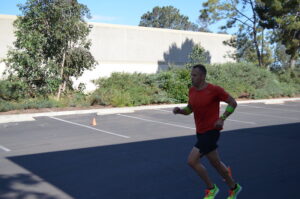 There are many aspects of training that you must consider in order to be success at OCR. You need to be an efficient runner and be skilled to complete obstacles. If you can do those two things, you are going to do very well in this sport.
There are many aspects of training that you must consider in order to be success at OCR. You need to be an efficient runner and be skilled to complete obstacles. If you can do those two things, you are going to do very well in this sport.
Sounds easy, but of course a lot of planning and hard work must go into this first. One huge piece of your training will be strength training. I am willing to bet you are already doing some form of strength training if you are reading this post. That is a great start. But not all strength programs are created equal and in some cases it may be hurting your performance.
The cool thing about strength training, is that when performed properly, it can help you be a better runner and help improve your success rate at all obstacles. That is a pretty impressive tool to have in your belt.
The two big reasons I put so much focus on strength training is it will help give you the strength needed to complete most obstacles and it will make you more resilient.
It is no surprise that when you lift weights you get stronger. You have probably figured that out already. But important thing to realize is you don’t need to be the strongest person in the world. You just need minimum levels of strength in order to complete obstacles. After this point, more strength may not help you anymore and potentially can set you up for injury if you are pushing too much weight.
So first use strength training to get as strong as you need to be. Of course this isn’t always easy to determine. If you find you complete most obstacles then you are probably there. Maintain that level and move onto the next piece. If you fail more obstacles than you would like, make sure you are improving strength where you need it.
Meet Minimums
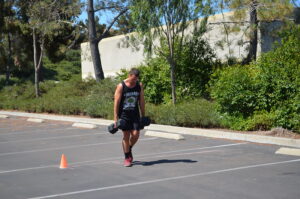 I like to see a few minimums to make sure there is adequate strength. For example, can you flex arm hang 30 seconds, dead hang 60 seconds, deadlift 1.5 x your bodyweight, squat your body weight, and carry 75% of your body for 90 seconds and 250ft. This isn’t perfect, but if you can do these things, I think you are pretty strong for what you need to be doing.
I like to see a few minimums to make sure there is adequate strength. For example, can you flex arm hang 30 seconds, dead hang 60 seconds, deadlift 1.5 x your bodyweight, squat your body weight, and carry 75% of your body for 90 seconds and 250ft. This isn’t perfect, but if you can do these things, I think you are pretty strong for what you need to be doing.
If this is all good, then we can focus on making your more resilient. In order to do this, we need to make sure your training is functional. This means we are challenging your body in different postures and positions, and placing load in difference places to help you thrive out on the course.
Many people still follow a more body building type program that focuses on using machines or fixed weights and working on building specific muscles. Unfortunately, this isn’t how we use our body in the real world or in racing. Our muscles work together with joints, fascia, and connective tissue in order to create movement. Our goal is to expose the body to as many movements as we can so it can get stronger in those positions.
By exposing your body to different ranges of motion, different movements, and different types of loading we can help prepare the body for whatever the race or life will throw at us. When you are looking at your training program make sure you are using a variety of equipment, holding weights in different ways, and training as many movement patterns as possible.
Holding Weight
When you look at how many ways you can alter an exercise just by changing equipment or changing where the load is, you start to see how many options you have. Dumbbells, Kettlebells, Sandbags, etc. seem like they can just be used interchangeably, but they all have unique benefits. So many sure you are changing the type of load you use regularly.
Also, pay attention to where you hold the weight. We can perform the exact same exercise, but simply change where or how you are holding the weight to make a dramatic change to the movement.

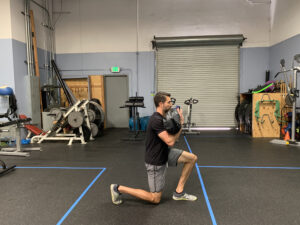 For example, lets look at a lunge. I could do a reverse lunge with a suitcase hold. This means both weights at my side. What if I get rid of one of the weights? This lightens the load but challenges my stability by pulling to one side without a counter weight. Or what if I take the same weight but use a sandbag and hold it at my chest. Now I get more activation of the core in order to perform the lunge. Finally I can take a KB and hold it overhead with my arm extended. This creates an even greater challenge put uses the lightest load. So keep in mind you don’t just progress with heavier weight. You challenge the body in a variety of other ways that may be more beneficial.
For example, lets look at a lunge. I could do a reverse lunge with a suitcase hold. This means both weights at my side. What if I get rid of one of the weights? This lightens the load but challenges my stability by pulling to one side without a counter weight. Or what if I take the same weight but use a sandbag and hold it at my chest. Now I get more activation of the core in order to perform the lunge. Finally I can take a KB and hold it overhead with my arm extended. This creates an even greater challenge put uses the lightest load. So keep in mind you don’t just progress with heavier weight. You challenge the body in a variety of other ways that may be more beneficial.
Movement Patterns
The next thing to look at is the hit as many movement patterns as possible and in as many planes of motion as possible. This can get complex, but we will try and keep it simple to get you started. In terms of movement patterns, the main movements you want to include each week are Squatting, Hinging, Lunging, Pushing, Pulling, and Gait. If we look deeper we can subdivide some of these as well. Lower body drills can be unilateral or bilateral and upper body drills can be horizontal or vertical (as well as unilateral or bilateral). Here is an example of all the movements and an exercise for that category.
- Bilateral Squatting – KB Goblet Squat
- Unilateral Squatting – DB Split Squat
- Bilateral Hinging – Hexbar Deadlift
- Unilateral Hinging – Single Leg Single Arm Deadlift
- Horizontal Pushing – Push Up
- Vertical Pushing – Half Kneeling Single Arm Press
- Horizontal Pulling – Bent Over Row
- Vertical Pulling – Pull Up
You won’t hit every movement every workout, but you can easily hit each at least once a week if you are training 2-3 days a week.
For example we could split it up as follows:
- Workout A
- Bilateral Squatting, Unilateral Hinging, Vertical Pushing, Horizontal Pulling, Gait
- Workout B
- Unilateral Squat, Bilateral Hinge, Horizontal Pushing, Vertical Pulling, Gait
The last piece would be to move in 3 planes of motion. If you notice all of the common exercises you probably think of for each category move in the sagittal plane. This include movements that typically go forward/backward or up and down.
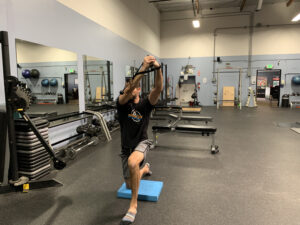 In real life we move in other directions as well, such as rotational and lateral. Throughout these movements make sure you are adding these other planes. For example, you may always do forward lunges. We can add lateral or rotational lunges. The same goes for all of the movement patterns.
In real life we move in other directions as well, such as rotational and lateral. Throughout these movements make sure you are adding these other planes. For example, you may always do forward lunges. We can add lateral or rotational lunges. The same goes for all of the movement patterns.
Think of this as you checklist. Your goal when you write a program is to make sure you are covering all of the above in there each week. I am willing to bet if we evaluated your workout we would see more checkmarks in some of these categories and maybe even none in others.
If you can do this you will have a much more balanced plan which will lead to more functional strength and resiliency.
Need Help Putting Your Plan Together?
If this topic interests you and you want to learn more about how to put together a complete training program from zone based running programs, strength training, obstacle skill development, mental training, and more, then check out my Certified OCR Specialist program. This is the most in depth course for coaches looking to understand the science and application for obstacle course race training.
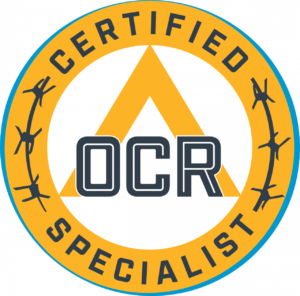
Click here to learn more and use code COCRS100 to save $100.
https://ocr-underground.newzenler.com/courses/certified-ocr-specialist

